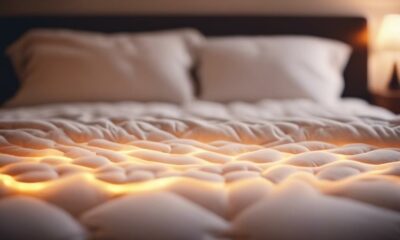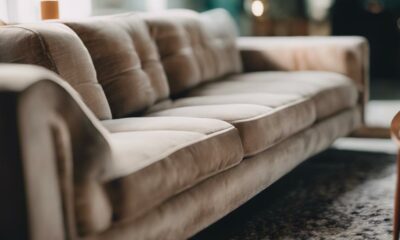Home Decor
10 Stylish Modern Urban Indonesian Home Decor Ideas
Love modern decor? Discover 10 stylish urban Indonesian home ideas that blend culture and contemporary design, transforming your space into a vibrant sanctuary.
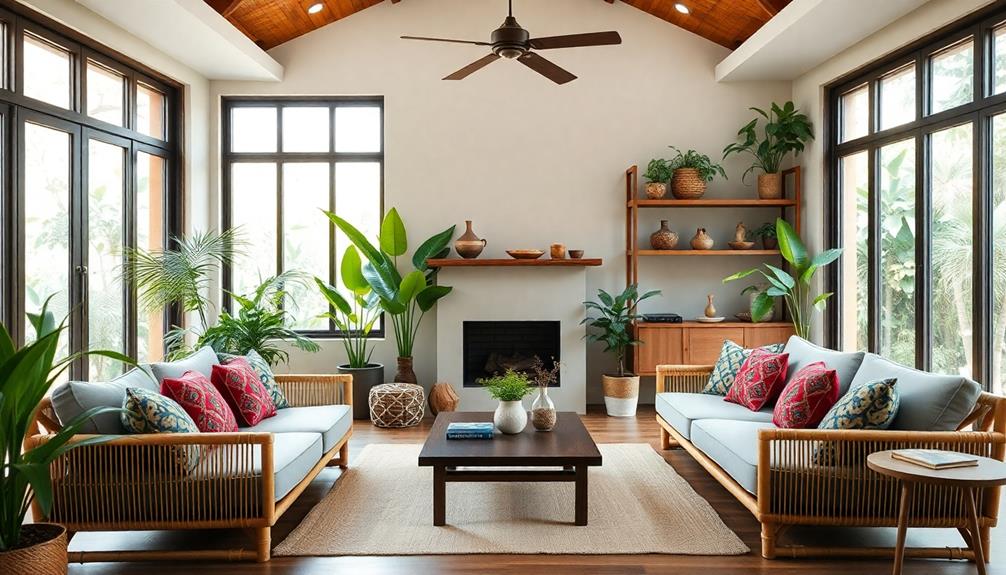
You can elevate your space with 10 stylish modern urban Indonesian home decor ideas that harmonize contemporary flair with cultural richness. Start by embracing natural materials like teak, bamboo, and rattan for sustainable elegance. Utilize open floor plans and large windows to invite light and foster indoor-outdoor connections. Opt for vibrant color palettes inspired by traditional Indonesians. Add artisan textiles and local artwork for unique charm. Integrate tropical plants for freshness and a lively atmosphere. Cozy reading nooks with rattan chairs create perfect relaxation spots. You'll discover even more creative tips to enhance your decor further.
Key Takeaways
- Incorporate natural materials like teak, bamboo, and rattan for sustainability and aesthetic appeal in modern urban homes.
- Design open floor plans that promote indoor-outdoor integration and enhance social interaction among family and friends.
- Use vibrant color palettes inspired by Indonesian culture, blending earthy tones with bold accents for a striking ambiance.
- Showcase artisan craftsmanship through local art, textiles, and handcrafted furniture, adding depth and cultural significance to decor.
- Create cozy reading nooks with comfortable seating, vibrant cushions, and indoor plants for a relaxing and inviting atmosphere.
Embrace Natural Materials

Embracing natural materials in your home decor not only elevates the aesthetic but also supports sustainability. By incorporating elements like teak, bamboo, and rattan, you can enhance the beauty of your space while promoting eco-friendliness.
These natural materials bring warmth and texture, creating a cozy atmosphere reminiscent of traditional Balinese homes. Additionally, using Indonesian Decorative Pillows can complement your decor with vibrant colors and intricate patterns that celebrate cultural heritage.
Consider adding hand-carved wooden furniture made from teak, which showcases exquisite craftsmanship and adds an elegant touch to modern interiors.
Locally sourced stone, such as volcanic rock, can also introduce a unique texture, reflecting Indonesia's rich natural heritage.
Don't forget to enrich your decor with natural fiber textiles like batik and ikat. These vibrant fabrics infuse your home with cultural artistry and authenticity, connecting you to Indonesia's artistic traditions.
Additionally, integrating indoor plants like ferns and orchids not only purifies the air but also fosters a seamless connection to the lush Indonesian environment.
Open Floor Plans
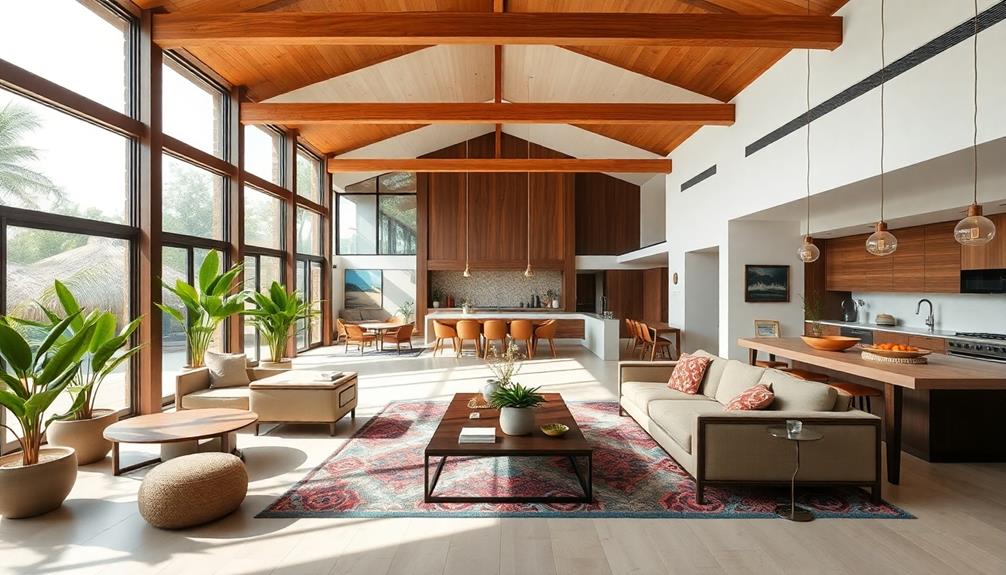
In modern Indonesian homes, open floor plans create a harmonious flow between living, dining, and kitchen areas, making your space feel more spacious and inviting. By emphasizing seamless integration, these layouts promote unity and encourage social interaction among family and friends. This design approach reflects the essence of Balinese design characteristics, where natural materials and open spaces enhance the connection to nature and foster a sense of community.
Imagine this:
- Large windows that flood your space with natural light
- Sliding doors that effortlessly connect indoor and outdoor spaces
- Warm wooden accents contrasting with sleek stone surfaces
- Colorful furniture that adds personality without overwhelming the design
- Cozy nooks perfect for relaxation or conversation
The use of natural materials enhances warmth and texture, giving your home an organic feel. This design approach not only reflects contemporary trends but also prioritizes functionality, making it ideal for urban living.
Open floor plans allow you to enjoy a lively atmosphere while still maintaining a sense of peace and tranquility. You'll appreciate how the flow between spaces encourages a vibrant lifestyle, letting you entertain guests or unwind at the end of the day in an effortlessly stylish setting.
Embrace the beauty of open floor plans and transform your home into a chic urban oasis.
Vibrant Color Palettes
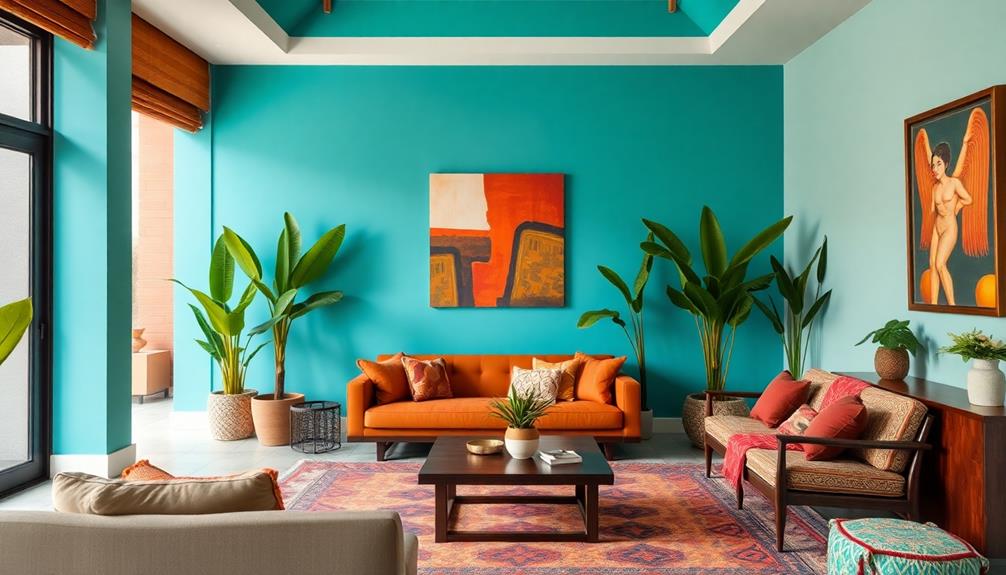
When it comes to vibrant color palettes in your Indonesian home decor, bold accent colors can really bring your space to life.
Incorporating traditional elements like those found in traditional Indonesian housing can inspire unique color choices that resonate with the rich cultural inspirations of the region.
Think about harmonious combinations that reflect the rich cultural inspirations of the region, like deep reds paired with turquoise.
Bold Accent Colors
How can you transform your living space into a vibrant retreat? By embracing bold accent colors, you can energize your home and create striking focal points that reflect Indonesia's rich cultural heritage.
Think vibrant color palettes like deep reds, rich blues, and bright yellows that capture the essence of tropical beauty. Incorporating elements such as traditional artistry through Indonesian decor masks can further enhance your decor, adding unique stories and cultural significance.
Here are some ideas to inspire your decor:
- An accent wall painted in a striking cerulean blue
- Colorful Batik throw pillows scattered across your sofa
- A bright yellow rug anchoring your living area
- Striking artwork featuring bold reds and greens
- A vibrant Ikat table runner adding flair to your dining space
These elements not only enhance the aesthetic but also infuse your home with personality and character.
Incorporating colorful textiles and decorative accessories allows for personal expression, making it easy to adapt your decor over time. With these bold accent colors, your living space will feel dynamic and engaging, creating a welcoming retreat that celebrates the vibrancy of urban Indonesian style.
Harmonious Color Combinations
Creating a harmonious color palette is essential to achieving a stylish modern urban Indonesian home. Vibrant color palettes often blend earthy tones like brown and beige with bold accent colors such as deep red, turquoise, and gold. This combination not only creates a lively atmosphere but also maintains balance throughout your space.
Consider incorporating a stunning Indonesian decor mask as a statement piece, which represents rich cultural heritage and adds a unique artistic expression to your decor.
To enhance the vibrancy, consider incorporating traditional textiles like batik and ikat. These rich patterns and colors will infuse character into your decor while connecting to Indonesian heritage.
Don't forget about the power of indoor plants; they purify the air and introduce natural hues and textures that beautifully complement your vibrant color schemes.
Lighting plays a vital role, too. Use ambient elements such as lanterns and handcrafted lamps to create a warm glow, enhancing the dynamic interplay of colors in your rooms.
To maximize the impact of your vibrant color palettes, make the most of large windows or sliding doors. Allow natural light to flood in, making the colors appear more vivid and inviting.
This thoughtful approach guarantees that your home not only looks stylish but also feels welcoming and alive.
Cultural Color Inspirations
Incorporating vibrant color palettes inspired by Indonesian culture can transform your home into a lively sanctuary. By embracing these cultural color inspirations, you'll create an interior design that not only looks stunning but also tells a story.
Integrating elements of traditional Indonesian style home decor can enhance the aesthetic appeal while maintaining cultural significance. Use dominant hues like deep red, gold, turquoise, and earthy tones to reflect the region's rich traditions.
To help you visualize, consider these vibrant elements:
- Deep red cushions that symbolize passion and warmth
- Gold accents in your decor, representing prosperity and luxury
- Turquoise wall art to echo the tranquil waters of Indonesia
- Earthy-toned rugs that ground your space in nature
- Lush green plants bringing the tropical landscape indoors
Incorporate Local Art
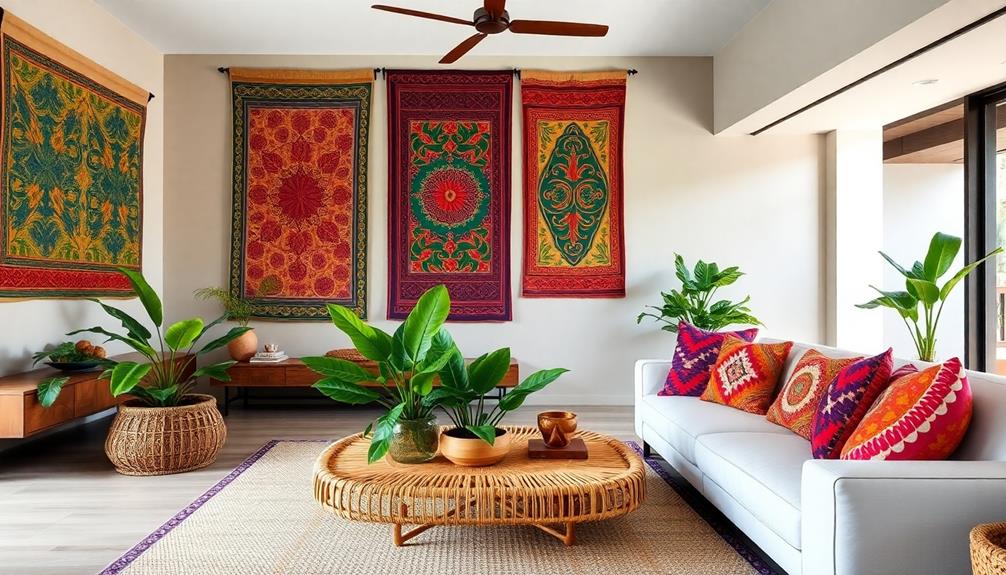
When you bring local art into your home, you instantly infuse your space with vibrant colors and rich cultural significance. Incorporating traditional Batik and Ikat textiles can create a striking contrast against modern furnishings, blending contemporary style with heritage.
Indonesian decor masks are also a fantastic addition, as their intricate designs often depict local myths and folklore, adding depth to your decor. Handcrafted wooden sculptures and intricate carvings from local artisans serve as stunning focal points, showcasing the rich craftsmanship that Indonesia is known for.
Consider wall hangings made from local materials to add texture and depth, reflecting the diverse artistic expressions found in various regions of Indonesia.
Artwork featuring traditional Balinese motifs, like lotus flowers or nature-inspired designs, can introduce a serene and spiritual ambiance, enhancing your Balinese interior and aligning with the principles of harmony.
Blend Indoor and Outdoor Spaces

One of the best ways to enhance your Indonesian home is by seamlessly blending indoor and outdoor spaces. This integration creates a harmonious environment that promotes a natural flow of light and air. You can achieve this look by incorporating large glazed doors that open up to your outdoor areas.
Open floor plans also work wonders, allowing your living areas to connect with lush gardens. Incorporating vibrant flower arrangements that reflect your cultural heritage can also help to create a welcoming atmosphere, reminiscent of Indonesian wedding decor ideas.
Consider these elements to elevate your indoor-outdoor experience:
- Spacious terraces that invite relaxation and social gatherings
- Natural materials like wood and stone to unify both spaces
- Water features such as ponds or fountains that bring tranquility
- Outdoor seating areas that mirror your indoor aesthetics
- Large windows that frame beautiful views and enhance natural light
Use Low-Profile Furniture
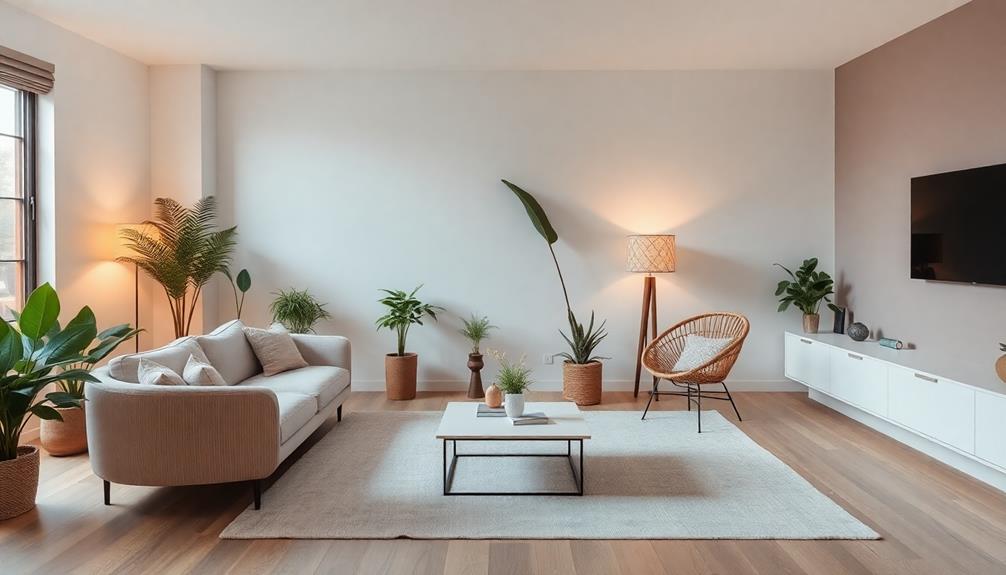
Low-profile furniture can transform your modern urban Indonesian home into a stylish, airy retreat. With its sleek and minimalist design, low-profile furniture enhances your space, making it feel open and welcoming. You'll find that low seating options, like sofas and coffee tables, create a relaxed atmosphere and promote easy interaction among family and friends.
Using natural materials such as wood and rattan in these designs aligns perfectly with sustainable practices, which are essential in contemporary Indonesian decor. This choice also emphasizes the aesthetic appeal of your home, allowing decorative elements and artwork to shine.
Here's a quick table to illustrate some ideas for incorporating low-profile furniture:
| Furniture Type | Suggested Material |
|---|---|
| Sofa | Rattan |
| Coffee Table | Teak Wood |
| Lounge Chairs | Bamboo |
| Bed Frame | Solid Wood |
| Side Tables | Recycled Materials |
Incorporating low-profile furniture not only enhances your home's style but also helps achieve a seamless indoor-outdoor flow, a hallmark of Balinese and modern Indonesian design. Embrace this trend for a chic and comfortable living space!
Integrate Tropical Plants

Creating a harmonious living space goes beyond furniture choices; integrating tropical plants can elevate your modern urban Indonesian home even further.
By choosing plants like palms, ferns, and orchids, you not only enhance the aesthetic appeal but also promote air purification and a calming atmosphere. Incorporating elements from expert tropical design can help you select the right plants that resonate with your overall decor style.
Large, leafy plants can serve as striking focal points, emphasizing the connection to nature that's essential in Balinese architecture.
To maximize your space and creativity, consider these ideas for incorporating tropical plants:
- A vertical garden, lush with greenery, can transform a bare wall.
- Terracotta or woven rattan pots complement the organic feel of your decor.
- Position plants near windows to guarantee they thrive and enhance the indoor-outdoor flow.
- Group plants of varying heights for visual interest and depth.
- Incorporate hanging planters to add dimension to your space.
Highlight Artisan Textiles
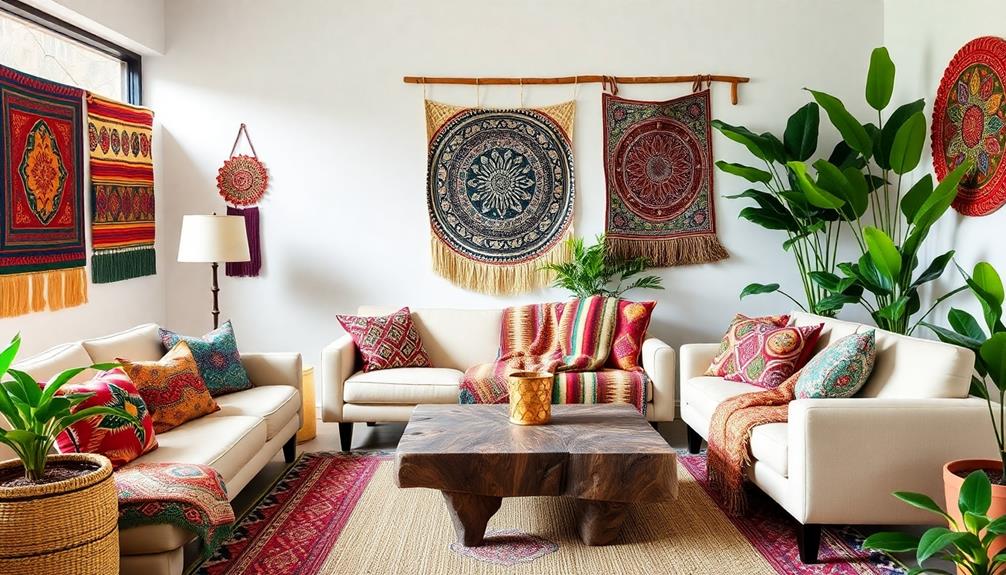
Incorporating vibrant handwoven fabrics into your decor can truly elevate your space.
These cultural textile patterns not only add visual interest but also tell a story of Indonesia's rich heritage. By showcasing these artisan pieces, you create a unique atmosphere that blends modern aesthetics with traditional craftsmanship.
Additionally, consider using these textiles in conjunction with tropical villa plans to enhance the open spaces and natural light of your home. This combination will further emphasize the serene and inviting atmosphere that defines modern urban Indonesian decor.
Vibrant Handwoven Fabrics
Vibrancy and authenticity come alive in modern urban Indonesian homes through the use of handwoven fabrics like Batik and Ikat. These artisan textiles are celebrated for their vibrant colors and intricate patterns, transforming any living space into a cultural haven.
By incorporating these textiles, you not only enhance the aesthetic appeal but also support local artisans and promote sustainability.
Imagine the warmth and charm these handwoven fabrics can bring to your home:
- Bold Batik-printed throw pillows that invite comfort
- Luxurious Ikat-covered upholstery adding texture to your furniture
- Colorful wall hangings that spark conversation and interest
- Soft cotton table runners that brighten your dining area
- Elegant silk curtains that dance with vibrant hues in the sunlight
Each piece of handwoven fabric reflects the unique heritage of Indonesian craftsmanship, offering a remarkable blend of style and cultural significance.
When you choose these textiles, you're not just decorating; you're celebrating a rich tradition, filling your home with character, and creating a cozy atmosphere that resonates with authenticity.
Cultural Textile Patterns
Artisan textiles like Batik and Ikat certainly bring a vibrant cultural essence to modern urban homes. These unique fabrics are integral to Indonesian culture, showcasing intricate patterns that reflect local traditions.
Batik, recognized by UNESCO, employs a wax-resist dyeing technique, resulting in detailed designs that often depict elements of nature or cultural symbols. You can easily incorporate Batik through cushions or wall hangings, allowing these stunning visuals to enhance your space.
On the other hand, Ikat textiles are crafted through a labor-intensive process where threads are dyed before weaving. This method produces blurred patterns that demonstrate the artisan's skill and keen eye for design.
Using Ikat in upholstery or decorative throws adds depth and warmth to your home decor.
Create Cozy Reading Nooks
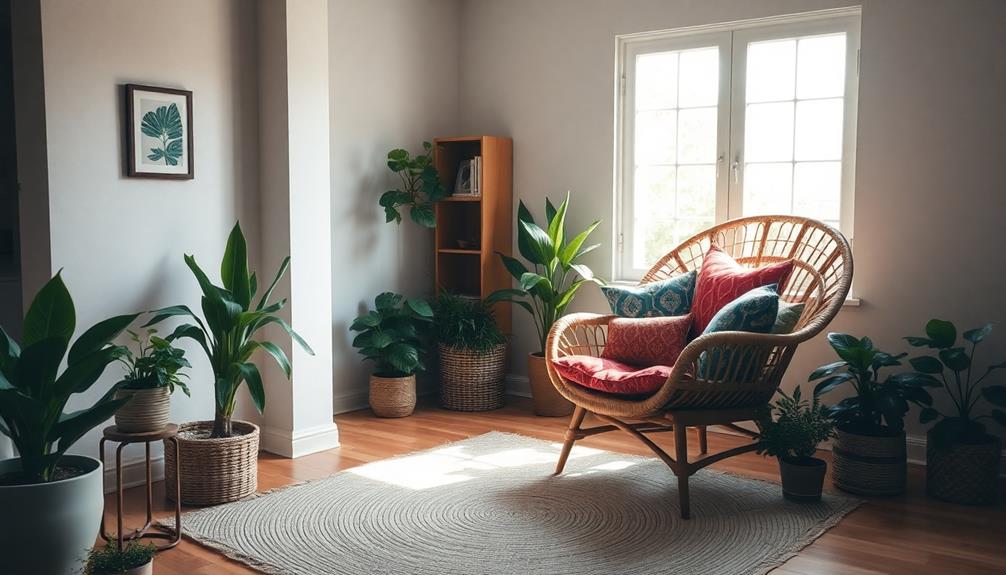
Creating a cozy reading nook can transform a corner of your home into a personal retreat where you can escape into your favorite books.
To achieve a Balinese-inspired interior, focus on comfort and style by incorporating elements that create a relaxed atmosphere.
- A comfortable rattan armchair or handmade ottoman to sink into while you read
- Vibrant Batik or Ikat cushions and throws to add warmth and cultural artistry
- Large windows or glazed doors that invite natural light and blur indoor-outdoor boundaries
- A small indoor plant, like a fern or orchid, to bring a touch of nature indoors
- A decorative wooden bookshelf with intricate carvings as a statement piece
Utilize Ambient Lighting
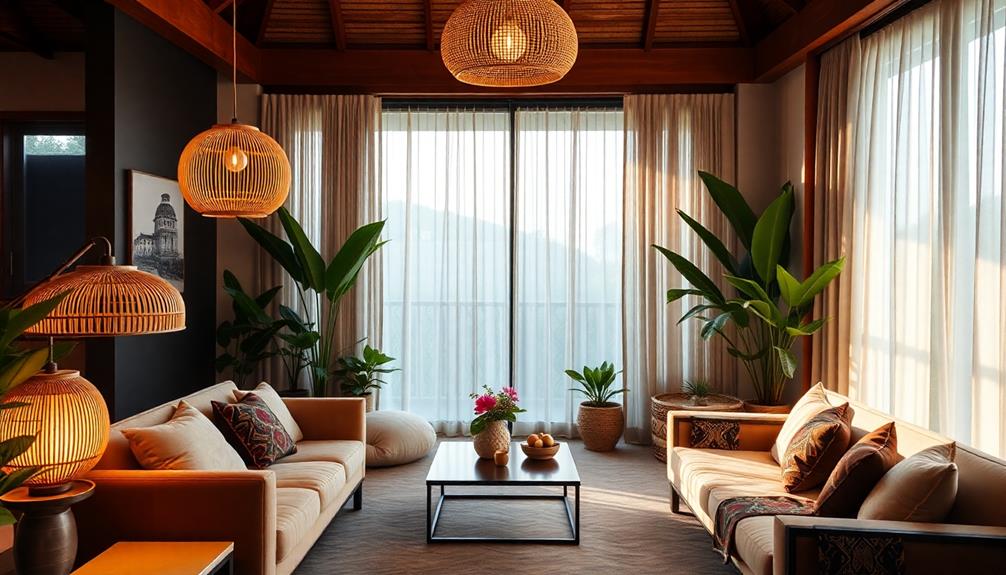
When you incorporate ambient lighting in your home, you create a warm and inviting atmosphere that instantly adds comfort.
Use pendant lights and floor lamps to highlight your design features while softening harsh shadows.
Warmth and Comfort
Ambient lighting plays an essential role in establishing warmth and comfort in your modern urban Indonesian home. By thoughtfully integrating various light sources, you can create a cozy atmosphere that invites relaxation and social interaction.
Consider using handcrafted rattan pendant lights that cast diffused light and shadow, enhancing the overall warmth. Layer your lighting with adjustable LED fixtures, allowing you to set the perfect mood for any occasion.
Here are some ideas to enhance your space:
- Soft-glowing floor lamps beside your comfy teak wood armchair
- Elegant table lamps illuminating your favorite reading nook
- Warm-toned wall sconces highlighting artwork or architectural features
- Large windows or sliding doors inviting in natural light, blurring indoor and outdoor spaces
- Strategically placed candles and lanterns that add an intimate touch
These elements not only promote comfort but also reflect the cultural aesthetic of Indonesian design.
Highlighting Design Features
Lighting can transform your Indonesian home by emphasizing its unique design features. To showcase your design style, consider incorporating ambient lighting that highlights the handcrafted elements typical of modern urban decor, such as rattan pendant lights. These fixtures not only provide diffused light but also infuse your space with local craftsmanship.
Layered lighting is vital for creating a warm and cozy atmosphere. Use various sources like floor and table lamps to achieve this effect. Dimmable LED lighting offers versatility, allowing you to adjust brightness based on the time of day and your mood.
Natural light plays an important role too. Large windows or sliding glass doors can blur the indoor-outdoor boundaries, enhancing the vibrancy of your decor by illuminating textures and colors. This connection with nature adds depth to your space.
Strategically placing ambient lighting can highlight focal points like sculptures or artwork, making them enchanting visual experiences.
Creating Relaxing Atmosphere
How can you create a truly relaxing atmosphere in your home? Start by utilizing ambient lighting to transform your space into a serene retreat. Incorporate various light sources that complement the natural light flooding in through your windows.
Here are some ideas to contemplate:
- Rattan pendant lights providing warm, inviting illumination
- Handcrafted table lamps adding a personal touch and soft glow
- Dimmable LED lights, allowing you to adjust brightness with ease
- Wall sconces and floor lamps to diffuse harsh shadows
- Candles and lanterns for that extra warmth and charm
Maximizing your window space and adding sliding glass doors can blur the lines between indoor and outdoor spaces, letting sunlight enhance your mood.
Together, these elements create a comforting atmosphere, perfect for unwinding after a long day. The right combination of ambient lighting and natural light not only elevates your decor but also nurtures relaxation, making your home a true sanctuary.
Frequently Asked Questions
What Are the Best Materials for Indonesian Home Decor?
When choosing materials for Indonesian home decor, consider natural fibers like bamboo and rattan, along with teak wood. These options not only reflect the culture but also add warmth and durability to your space.
How Can I Mix Traditional and Modern Indonesian Styles?
Blend vibrant textiles with sleek furniture to create harmony. Incorporate traditional batik patterns on modern cushions, or use carved wood accents alongside minimalist decor. You'll effortlessly bridge the gap, creating a space that tells a fascinating story.
What Are Unique Indonesian Decorative Accents to Consider?
You should consider incorporating batik textiles, hand-carved wooden sculptures, or intricate wayang kulit shadow puppets. These unique accents not only reflect Indonesian culture but also add depth and character to your home's decor.
How Do I Choose the Right Indoor Plants for My Space?
To choose the right indoor plants for your space, consider light conditions, humidity levels, and your maintenance preferences. Opt for varieties that thrive in your environment, ensuring they complement your decor while enhancing air quality.
What Are Common Mistakes in Urban Indonesian Home Decor?
Decorating's like cooking; the wrong ingredients can ruin the dish. You might overcrowd spaces, ignore lighting, or mismatch styles. Keep it balanced, focus on functionality, and let your personality shine through for a harmonious home.
Conclusion
As you weave these stylish decor ideas into your urban sanctuary, imagine your home as a vibrant tapestry, each thread representing a piece of Indonesia's rich culture. By embracing natural materials and lush greenery, you create a serene haven that invites both comfort and creativity. Let the colors dance like a sunset, and the textures tell stories of tradition. Your space becomes more than just a home; it transforms into a warm embrace of modern elegance and cultural heritage.
Interior
Does Interior Paint Increase Home Value
Yearning to discover how interior paint can skyrocket your home's value? Get ready to unlock the secrets that will transform your space!
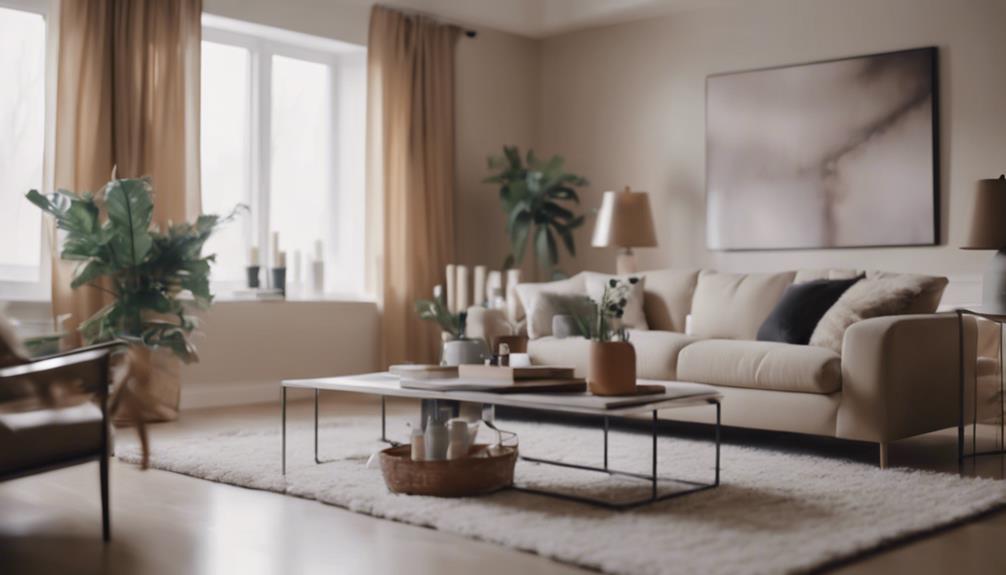
Interior paint plays a crucial role in increasing the value of your home by impressing potential buyers with a cohesive, fresh appearance. The color palettes you select have a long-lasting impact on how your home is perceived, influencing its attractiveness and market value. Choosing high-quality paint and strategic color combinations, such as neutrals, can significantly enhance the value of your property. Additionally, remember to update your interior paint every 7-8 years to maintain that fresh, welcoming atmosphere. Investing in top-notch paint and thoughtful color choices can greatly improve your home’s value and overall visual appeal. Are you ready to enhance the value of your home?
Key Takeaways
- Neutral colors and consistent schemes boost perceived value.
- Quality professional paint jobs command higher prices.
- Regular repainting every 7-8 years enhances home appeal.
- Strategic color choices significantly impact home value.
- Fresh, neutral paint increases space perception and curb appeal.
Importance of Interior Paint in Home Value
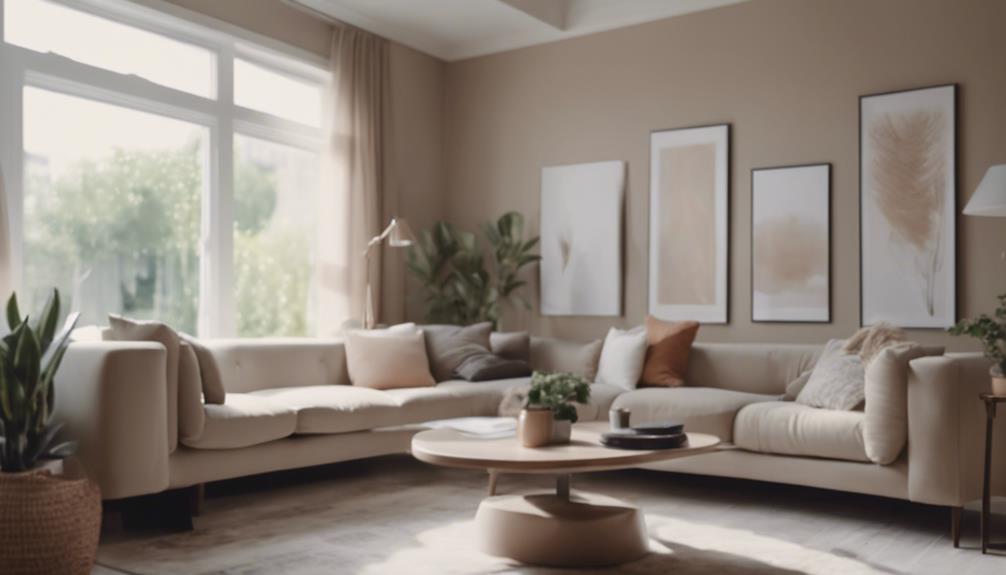
When contemplating the importance of interior paint in determining home value, it's crucial to understand its direct impact on potential buyers' perceptions and the overall financial return on investment.
The colors you choose to paint your walls can greatly influence how buyers view your home. A fresh coat of paint can enhance the perceived value of your home, showing that you have taken good care of the property. Consistent color schemes throughout the house can create a sense of flow and unity, making the space more appealing to potential buyers.
Additionally, repainting every 7-8 years with neutral colors can help maintain a fresh and updated look, maximizing the value of your home. Neutral colors have broad appeal and can make spaces appear larger, which is attractive to buyers. By investing in quality interior paint and choosing the right colors, you can significantly enhance the value of your home and make it more appealing to potential buyers.
Factors Influencing Home Value Through Paint
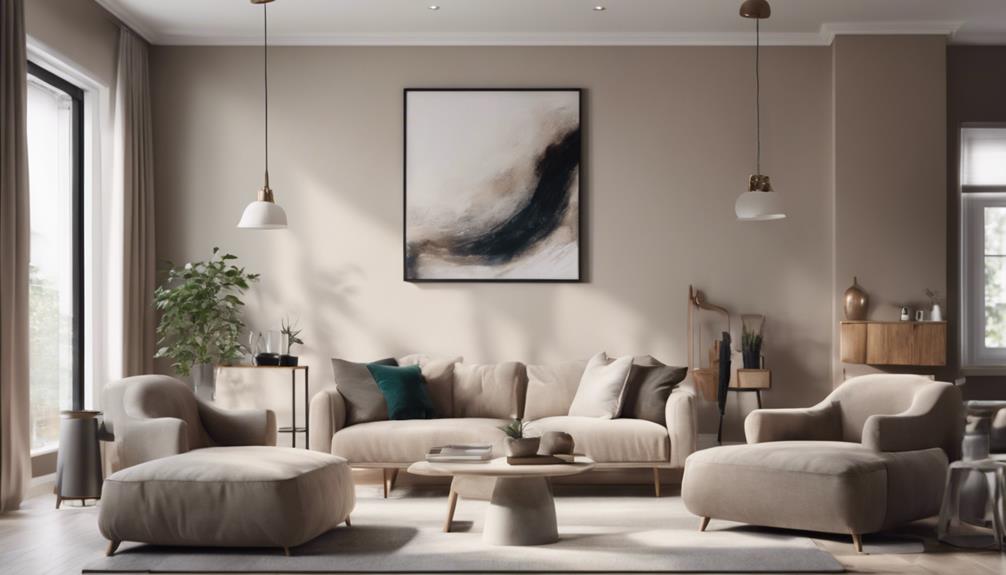
Factors that influence home value through paint include the choice of colors, the quality of the paint job, and the consistency of color schemes throughout the property. Neutral paint colors are highly recommended as they appeal to a broader range of buyers and can positively impact the perceived home value. Opting for professional interior paint jobs not only showcases good maintenance and care but also allows you to command higher prices in the real estate market. Consistent color schemes across your home can greatly improve flow and unity, enhancing the overall appeal and value of the property. Investing in quality interior paint can lead to a remarkable 107% return on investment, making it a wise choice for increasing your home's value. Take a look at the table below for a quick overview of how these factors can impact your home value:
| Factors to Take into Account | Impact on Home Value |
|---|---|
| Neutral Paint Colors | Positive |
| Professional Paint Jobs | Higher Prices |
| Consistent Color Schemes | Enhanced Appeal |
| Quality Interior Paint | Significant ROI |
Choosing the Right Colors for Value
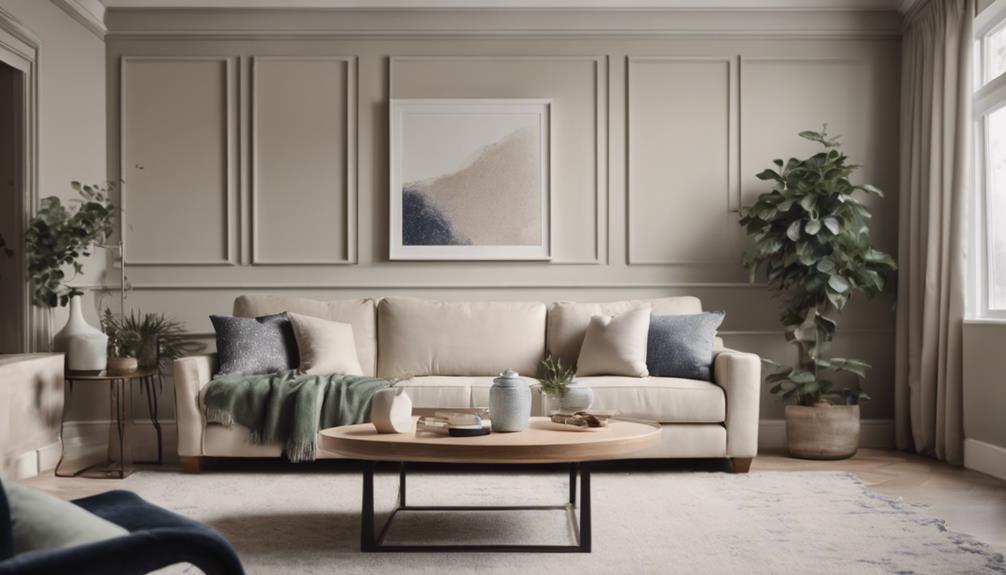
For maximizing your home's value through paint selection, prioritize choosing neutral shades like beige, tan, and greige. When selecting colors for value, keep in mind the impact they can have on your home's overall worth. Specific colors can make a significant difference in boosting your home's curb appeal and perceived value.
Consider the following tips for choosing the right paint colors:
- Darker Colors for Doors: Darker hues like gray, black, or navy blue on doors can add a touch of sophistication and elevate the asking price of your home.
- Light Blue-Gray Kitchens: Opting for light blue-gray tones in kitchens can make your home more appealing to potential buyers and potentially fetch higher selling prices.
- Bold Accent Colors: Using bold accent colors on doors or shutters can create visual interest and enhance the overall value of your property.
- Warm Neutrals: Warm neutrals such as tans and light taupe can help create a welcoming atmosphere and positively impact the perceived value of your home.
Enhancing Home Value With Fresh Paint
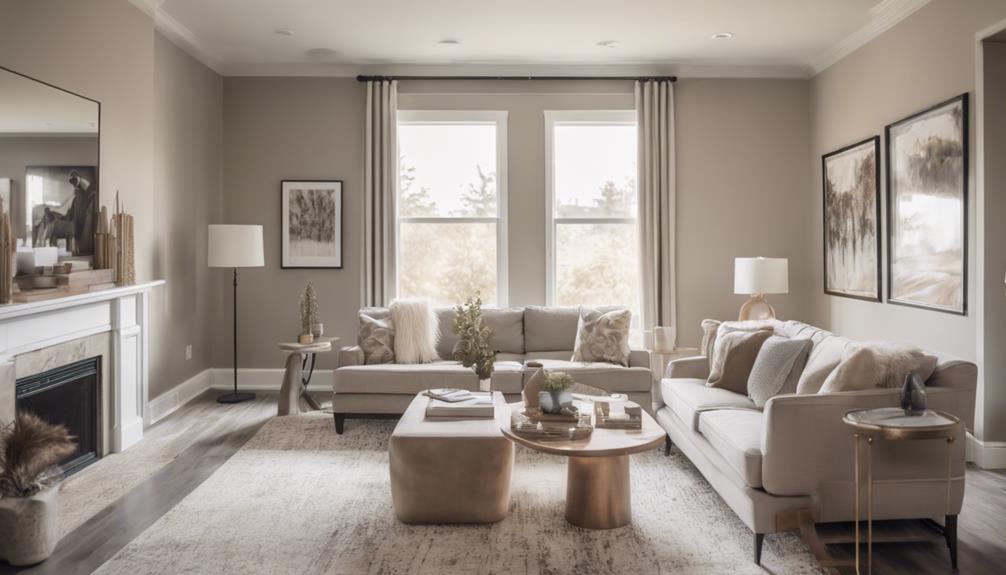
Enhancing your home's value with a fresh coat of paint can be a highly effective and lucrative investment. A fresh interior paint job not only refreshes the look of your home but also has the potential to increase its value substantially.
When potential buyers walk into a home with crisp, freshly painted walls, they immediately see a space that's well-cared for and move-in ready. This first impression can make a big difference in how they perceive the value of the property.
Whether you're painting a single room or giving the exterior a fresh new look, investing in painting as part of your home improvements can pay off in the long run. Fresh, neutral colors can make rooms appear more spacious and inviting, while a well-executed exterior paint job can boost curb appeal and attract more interest from potential buyers.
Maximizing ROI With Interior Paint
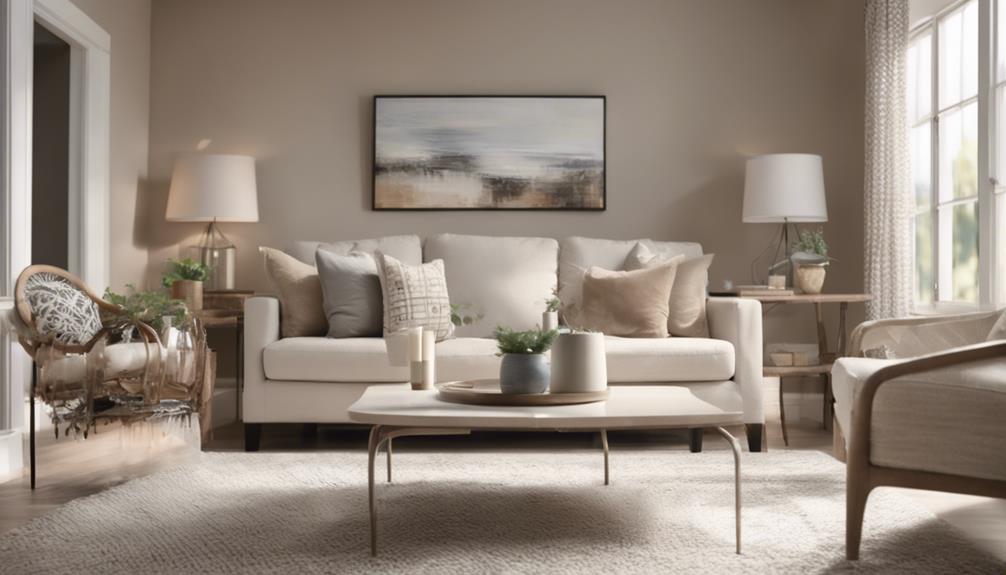
To maximize your return on investment with interior paint, consider the impact of color choices on perceived home value and overall appeal. When aiming to increase your home's ROI through painting, keep these key points in mind:
- Choose Neutral Colors: Opting for neutral tones can elevate the perceived value of your home, appealing to a wider range of potential buyers.
- Regular Maintenance: Repainting every 7-8 years is essential for maintaining your home's value and keeping it looking fresh and well-cared for.
- Consistent Color Schemes: Creating a consistent color palette throughout your house enhances flow and unity, making the space feel cohesive and inviting.
- Maximize Value: By strategically repainting key areas with attention to detail and quality, you can greatly enhance the overall value of your home.
Frequently Asked Questions
What Paint Color Increases Home Value?
Choosing the right paint color can greatly impact your home value. Neutral shades like light gray, beige, and greige are safe bets for increasing attractiveness. Dark colors such as charcoal gray, navy blue, or black on doors can elevate property prices.
Timeless exterior colors boost curb appeal, attracting buyers. Soft blues, greens, and yellows create inviting exteriors. Bold accent colors on doors or shutters add flair and value to your home.
Does Fresh Interior Paint Help Sell a House?
Fresh interior paint can work wonders when selling a house. Did you know that homes with freshly painted interiors tend to sell faster?
That's right! A fresh coat of paint can make your space look newer and more appealing to potential buyers. It's like giving your home a facelift that attracts more attention.
What Is the Best Interior Paint Color for Selling Your Home?
When choosing the best interior paint color to sell your home, go for neutral tones like grays, beiges, or greiges. These colors have broad appeal and can attract a wider range of potential buyers.
Soft blues and greens create a welcoming atmosphere, while bold accent colors on doors or shutters can increase your home's value.
How Much Value Does Paint Add?
Adding a fresh coat of interior paint to your home can greatly impact its value. On average, interior painting can increase your home's worth by $2,112! This high return on investment of 107% makes it a smart choice.
Selecting quality paint and cohesive color schemes can enhance the overall appeal of your home. With the right colors, you can even make your spaces feel larger or cozier, positively influencing your home's value.
Conclusion
So, next time you're thinking about sprucing up your home, remember that a fresh coat of interior paint can truly make a difference in its value.
Some may argue that paint is just a cosmetic change, but in reality, it can greatly enhance the overall appeal and marketability of your home.
Don't underestimate the power of paint when it comes to maximizing your return on investment!
Home Decor
What Is Eclectic Home Decor
Boldly mix styles, colors, and textures in eclectic home decor to create a truly unique and personalized living space.
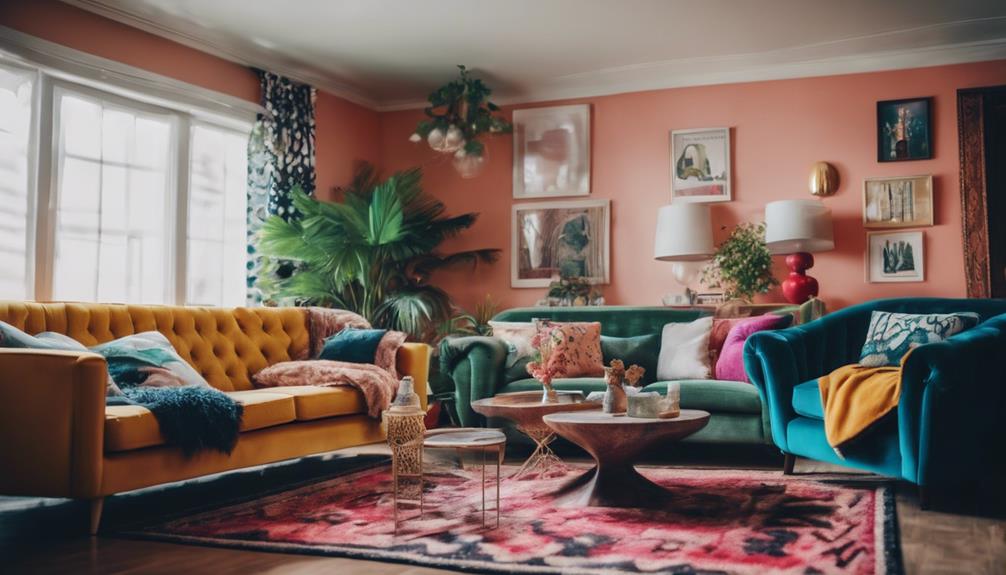
Eclectic home decor combines elements from various styles, periods, and cultures to create a one-of-a-kind living space. This design approach originated in the late 19th to early 20th century, veering away from traditional norms to offer a customized look. Embracing creativity, it melds vintage and modern furniture while incorporating vibrant accent colors for a lively touch. By playing with contrasting pieces and blending textures and colors, you can achieve a visually dynamic and personalized aesthetic that mirrors your uniqueness. Delve deeper into mixing styles, incorporating color and texture, and customizing your space for an authentically eclectic and distinctive home decor experience.
Key Takeaways
- Eclectic home decor mixes different styles, periods, and cultures for a unique look.
- It embraces creativity, individuality, and personal expression in design.
- The style incorporates a diverse range of textures, colors, and patterns.
- Blend vintage and modern furniture for a harmonious space.
- Bold accent colors add energy and personality to eclectic decor.
Origins of Eclectic Decor
Originating as a response to architectural movements rejecting specific styles, eclectic home decor emerged as a design style in the late 19th to early 20th century. This unique style breaks away from traditional design norms by incorporating various elements from different periods, styles, and cultures.
Drawing inspiration from global influences, eclectic decor embraces diversity, mixing patterns, colors, and textures to create a visually stimulating environment. The architectural style that inspired eclectic decor encouraged a blend of old and new elements, providing a platform for individuals to showcase their personality through their home interiors.
The eclectic style is characterized by its unpredictability and variety, allowing for a personalized and expressive design approach. By combining elements from around the world, eclectic decor enables individuals to curate spaces that are both harmonious and diverse, reflecting a thoughtful and purposeful design aesthetic.
Key Elements of Eclectic Design
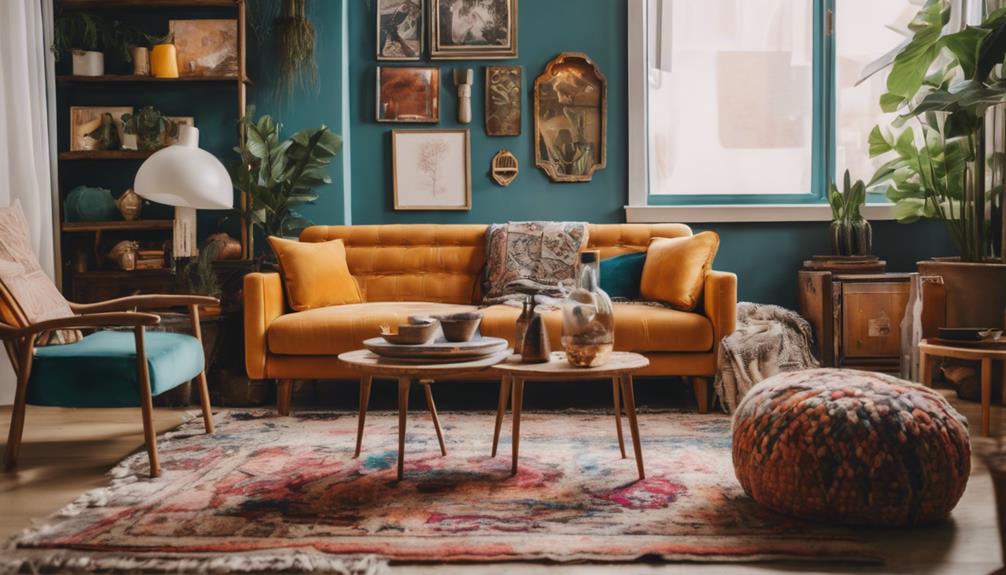
In eclectic design, mixing and matching different styles, periods, and elements is a key element that allows for a unique and visually interesting space. This approach to interior design embraces creativity, individuality, and personal expression.
The eclectic design style thrives on the unexpected, blending old and new pieces seamlessly. A hallmark of eclectic design is the incorporation of a diverse range of textures, colors, and patterns. This mix creates a visually dynamic and vibrant aesthetic within a space.
By combining elements from various design styles, eclectic decor achieves a harmonious fusion that's both visually stimulating and engaging. In eclectic home decor, you can expect to see a blend of vintage and modern furniture, artwork from different eras, and bold accent colors that add energy and personality to the room.
These key elements work together to create an eclectic space that's truly one-of-a-kind.
Mixing Styles in Eclectic Decor
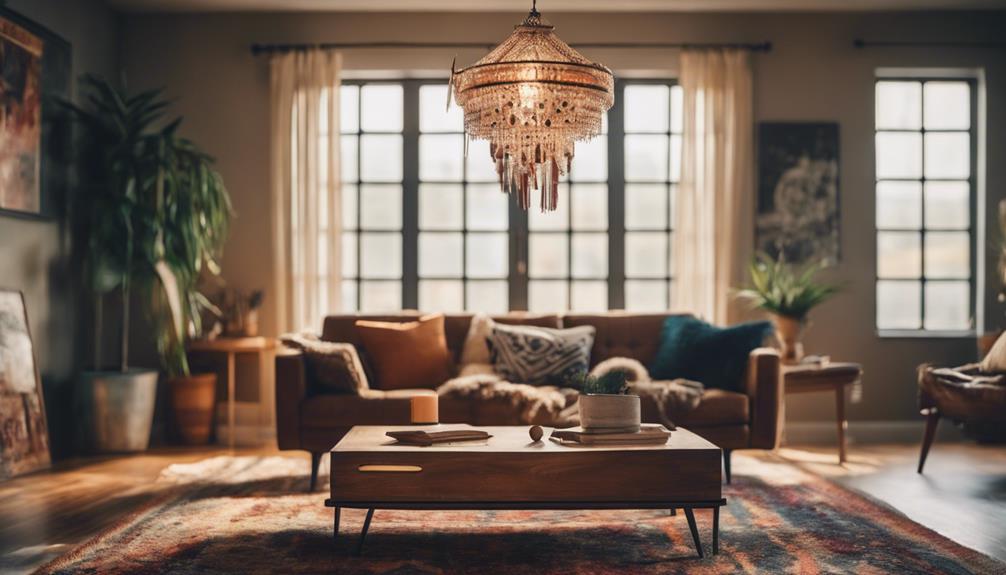
Mixing different styles in eclectic decor creates a visually engaging and personalized look by blending traditional, modern, vintage, and global influences seamlessly. When incorporating various design elements, achieving a balance is crucial to create a cohesive and harmonious space. Here are three key ways to successfully mix styles in eclectic decor:
- Mix and Match: Experiment with contrasting pieces to add depth and interest to your space. Combine a contemporary sofa with antique chairs or mix bold patterns with solid colors to create a dynamic visual impact.
- Blending Traditional and Modern: Blend classic elements like ornate mirrors or vintage rugs with modern furniture to create a unique juxtaposition. This fusion of styles adds character and sophistication to your design.
- Personalized Design Aesthetic: Infuse your personality into the decor by incorporating items that resonate with you. Display cherished mementos, travel souvenirs, or family heirlooms to create a space that reflects your individuality and story.
Incorporating Color and Texture

Let's explore how color and texture play essential roles in creating a visually stimulating and dynamic eclectic home decor.
In eclectic decor, a mix of bold and neutral colors is often used to create a visually stimulating environment. This combination adds depth and interest to the space.
Texture is another vital element in eclectic design, as it involves blending rough and smooth textures to enhance the overall ambiance. By incorporating a variety of textiles such as velvet, silk, and wool, the richness of eclectic spaces is elevated.
Additionally, layering different patterns contributes to the unique and dynamic feel of eclectic decor.
When color and texture are harmoniously integrated into eclectic home decor, they work together to create a personalized space with a diverse aesthetic. This blending of elements helps in achieving a cohesive and visually appealing look that's both inviting and intriguing.
Personalizing Your Eclectic Space
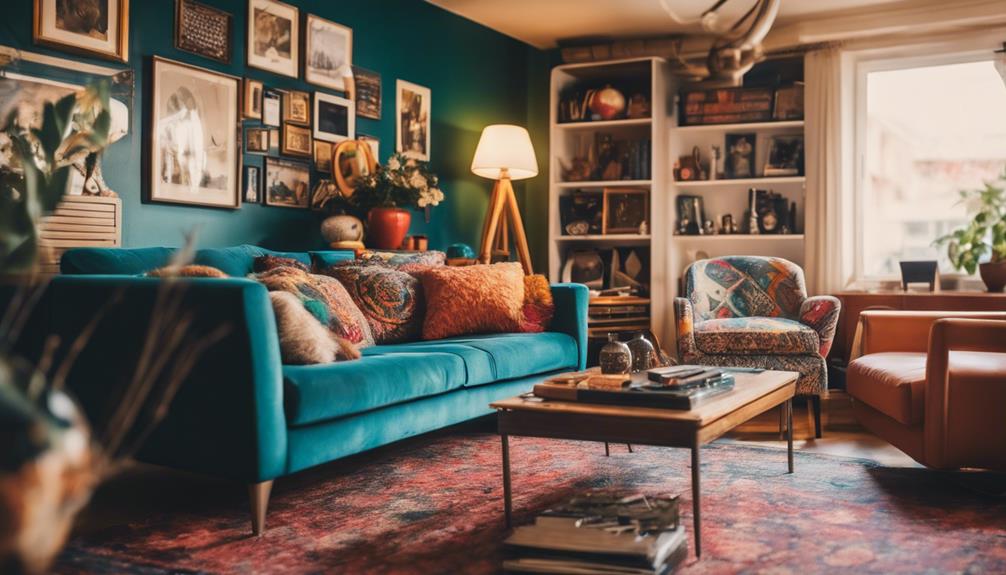
When personalizing your eclectic space, we can create a unique blend of decor that reflects our individual style and interests.
By experimenting with a mix of textures, patterns, and colors, we can craft a visually engaging environment that speaks to our personality.
Showcasing our personal flair through curated art, decor, and meaningful mementos can infuse our eclectic space with character and authenticity.
Unique Decor Combinations
Creating a space that reflects your unique personality through a blend of diverse decor elements is the essence of personalizing an eclectic home. When combining vintage and modern pieces with diverse patterns, consider the following:
- Mixing Textures: Incorporate a variety of textures like plush rugs, smooth metals, and rough wood to add depth and visual interest to your space.
- Playing with Colors: Experiment with bold color combinations or stick to a neutral palette while adding pops of color through accent pieces for a vibrant look.
- Balancing Scale: Mix large statement pieces with smaller items to create a visually balanced composition that draws the eye around the room.
Showcasing Personal Style
To truly showcase our personal style in an eclectic space, we infuse it with elements that resonate with our individuality and story. Personalizing our eclectic home decor involves incorporating personal mementos, travel souvenirs, and favorite items to add a unique touch.
By displaying items that hold sentimental value, we create a sense of nostalgia and connection within our space. Mixing and matching elements that reflect our tastes and interests allows us to craft a truly personalized eclectic home decor.
Ensuring that we infuse our space with pieces that speak to us guarantees that our eclectic decor reflects who we're and the journey we've been on. Embracing these personalized touches helps make our home a true reflection of our eclectic and personal style.
Tips for Achieving Eclectic Style
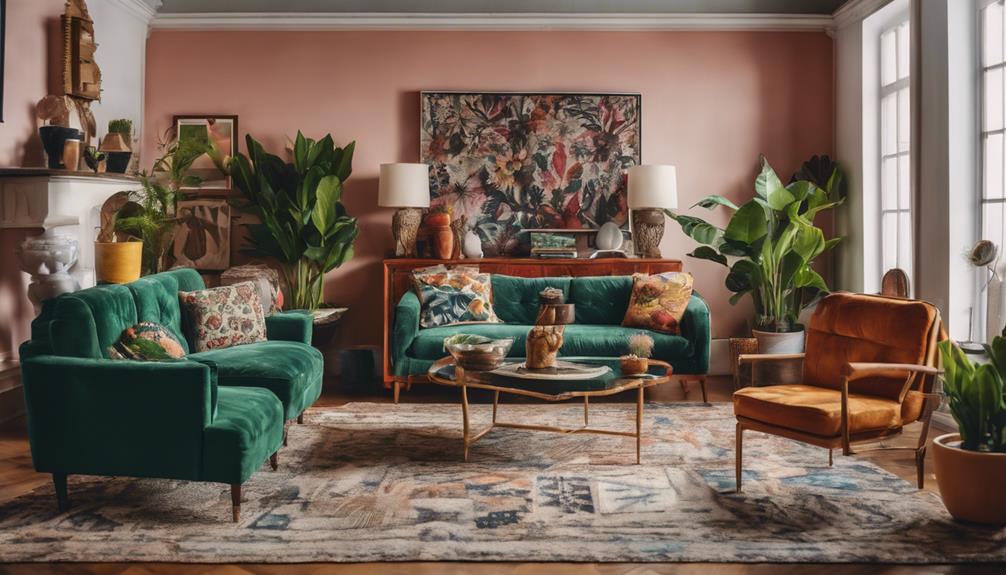
For achieving an eclectic style, starting with a neutral base sets a versatile foundation for your decor. This allows you to easily incorporate a mix of colors, patterns, and textures without overwhelming the space. Here are three key tips for achieving an eclectic style:
- Mix Furniture Styles: Blend different furniture styles in varying proportions to create a dynamic and personalized look. Pair modern pieces with vintage finds or mix sleek lines with intricate details to add visual interest.
- Layer Textiles: Utilize rugs, throws, and pillows to add layers of texture to your space. Mixing different fabrics, patterns, and colors can enhance the cozy and inviting feel of an eclectic room.
- Showcase Personal Collections: Display your personal collections and artwork to infuse your space with individuality and character. Whether it's vintage vinyl records, travel souvenirs, or family heirlooms, incorporating these elements can make your eclectic decor truly unique.
Frequently Asked Questions
How to Make Your House Look Eclectic?
To make your house look eclectic, we blend various furniture styles like vintage and modern pieces. We mix materials such as velvet and silk for textures and display a diverse art collection with personal mementos.
Experiment with different lighting sources to create ambiance and add finishing touches like plants and rugs. By combining these elements, we can achieve a unique and visually interesting eclectic home decor style.
What Does Eclectic Mean House?
Eclectic in a house means blending diverse styles, periods, and origins for a unique look. It involves mixing textures, colors, and materials creatively.
This style allows for showcasing individuality and diverse tastes through unexpected decor combinations. Mixing old and new elements purposefully creates a visually interesting space.
The approach is all about embracing variety and personal expression in design.
What Is the Difference Between Eclectic and Bohemian Decor?
Eclectic decor mixes various styles, periods, and textures for a personalized look.
Bohemian decor, on the other hand, leans towards a relaxed, globally inspired aesthetic.
Eclectic intentionally blends diverse design elements, while bohemian has a more organic and spontaneous vibe.
Bohemian often features natural materials and earthy tones with eclectic patterns, while eclectic embraces a broader range of design influences.
Both styles value individuality and creativity but showcase distinct visual expressions in home decor.
What Are Eclectic Ideas?
Eclectic ideas in home decor involve combining diverse styles, periods, and cultures to create a unique and visually alluring space. By blending old and new elements, unexpected decor touches, and purposeful design choices, eclectic decor allows for a mix of furniture, accessories, colors, and patterns that reflect individuality and creativity.
How can we infuse our living spaces with a sense of personality and character through eclectic design choices?
Conclusion
To sum up, eclectic home decor is a versatile and creative design style that allows for the mixing of different elements and styles to create a unique and personalized space.
Did you know that 85% of interior designers believe that incorporating eclectic decor can add personality and character to a room?
By following the key elements and tips for achieving eclectic style, you can create a visually interesting and inviting home that truly reflects your personality and taste.
Wall Art and Decor
How Long to Paint Interior of New House
Delve into the process of painting a new house to discover how different factors impact the duration and quality of the project.
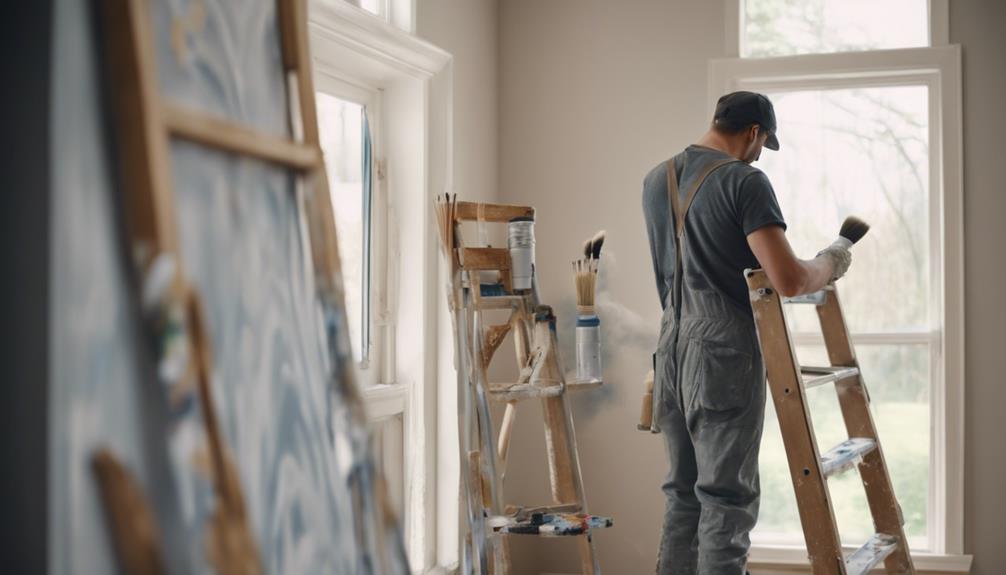
To complete the painting of the interior of a new home, it typically takes around 3.5 weeks. This timeframe accounts for addressing any imperfections resulting from fresh construction, as well as the necessary time for preparation and painting. Variables such as the home’s size, materials used, and quality of workmanship can impact how long the process takes. Enlisting the help of professionals can speed up the project and ensure a top-notch outcome. Thorough preparation work is crucial for achieving a flawless final result. If you’re interested in learning more about efficiently painting a new home, continue exploring the factors that influence painting duration and preparation to gain a comprehensive understanding.
Key Takeaways
- Consult professionals for accurate time estimates.
- Size, intricacy, and surfaces affect painting time.
- Prep work like cleaning, sanding, and taping is crucial.
- New builds with imperfections require extra preparation.
- Efficient techniques streamline the painting process.
Factors Affecting Painting Time
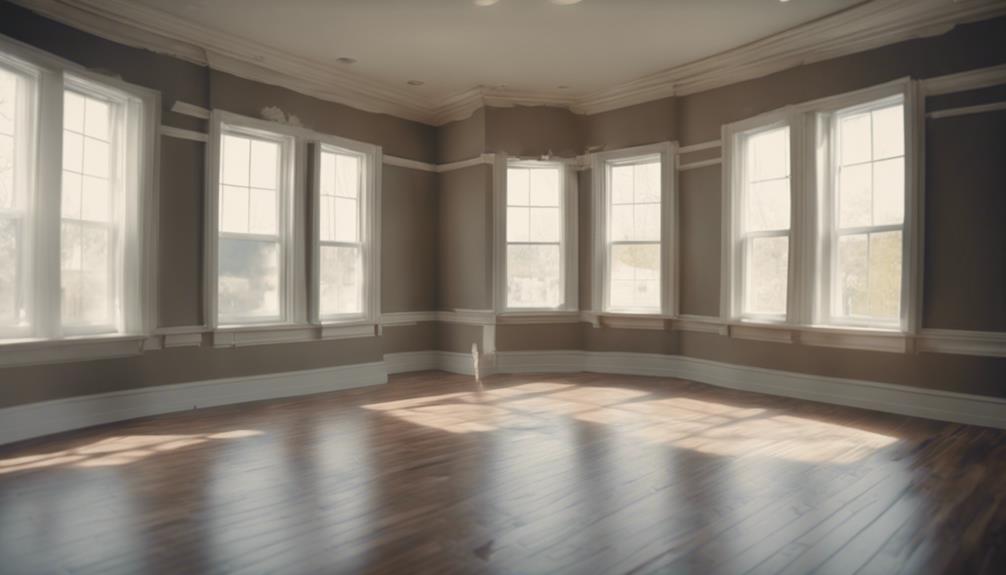
When pondering the time needed to paint the interior of a new house, various factors greatly influence the painting duration. Professional painters typically estimate around 3.5 weeks to complete the painting of an entire new house, especially when meticulous work is required for a fresh build.
New construction often comes with imperfections that demand additional prep work, impacting the overall painting timeline. Factors such as different materials used, higher ceilings, and the level of quality workmanship can also impact the time needed to paint a new house.
It's important to consult with multiple painters to get accurate time estimates and to take into account potential unexpected delays or touch-ups that may be needed for a precise completion timeline. By being aware of these factors and planning accordingly, you can ensure a smoother and more efficient painting process for your new home.
Size of the House
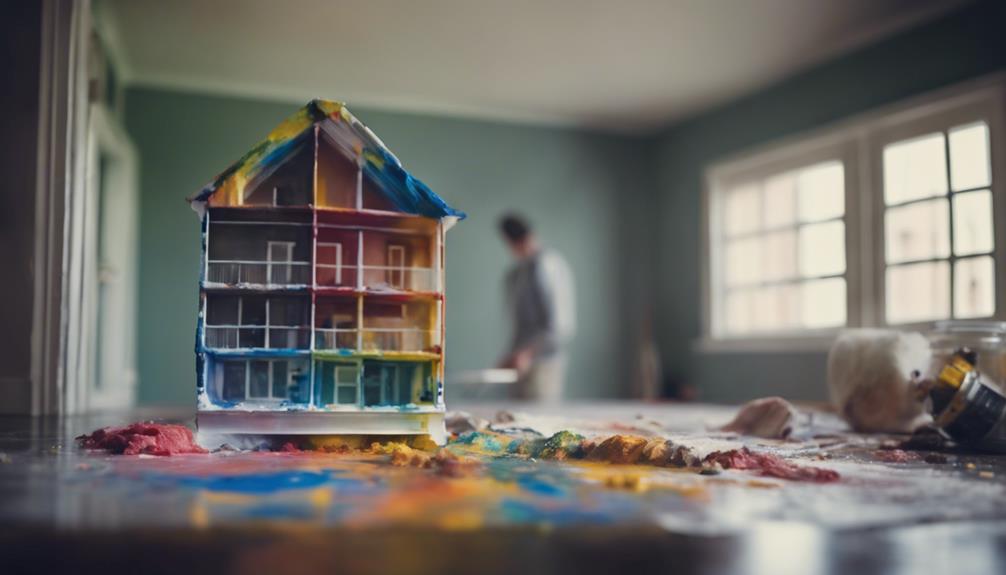
When considering the time needed to paint the interior of your new 2900 square foot house, the size of the house plays an important role. The larger the square footage and the more rooms you have, the more time-consuming the painting process will be.
Factors such as the number of walls and ceilings to paint will contribute to the overall timeline for completing the project.
House Square Footage
Considering the size of the house at 2900 square feet, the painting process will require careful planning and efficient execution. The square footage of the house, along with the 10-foot ceilings downstairs and 9-foot ceilings upstairs, will impact the time needed for painting.
The presence of a few built-ins means extra care will be needed around those areas. Luckily, the kitchen cabinets don't require painting, which can save time during the painting process.
The specifics of this new build play an important role in determining the overall painting time. With a house of this size and these features, it's essential to factor in all these details when planning the interior paint job.
Number of Rooms
To efficiently paint the interior of a new house, the number of rooms plays a crucial role in determining the overall time required for the job. A house with fewer rooms will generally take less time to paint compared to a house with a higher number of rooms.
For instance, a small house with only a few rooms might take around 24 days to complete the painting process. On the other hand, a larger house with multiple rooms, especially those with 3 stories and 5+ bedrooms, could extend the painting duration to approximately 57 days.
The size of the house, considering the number of rooms, significantly impacts the timeline for completing the paint job in both new construction and renovation projects.
DIY Vs Professional Painting
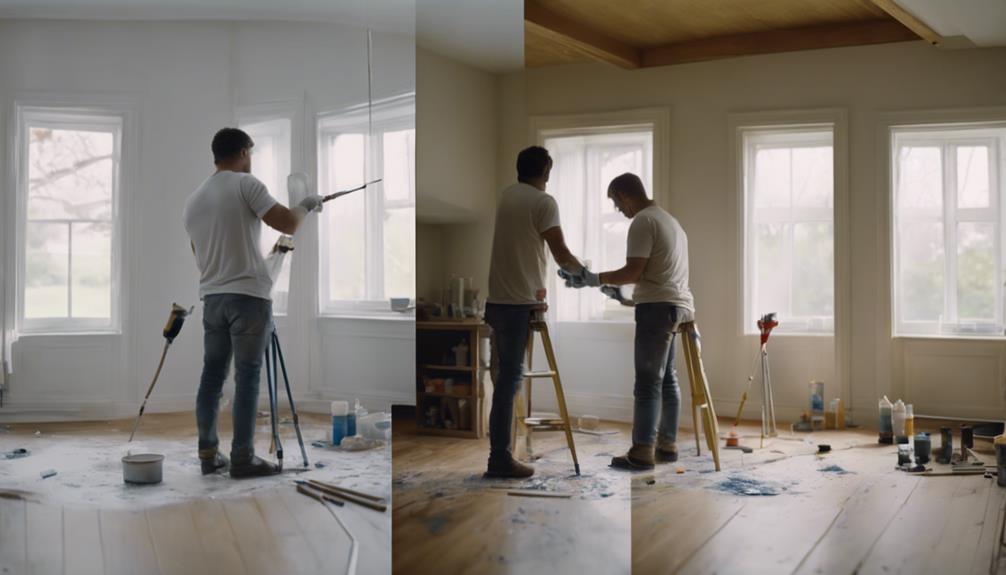
For the best results in painting the interior of your new house, considering the benefits of DIY painting versus hiring professionals is crucial. Here are a few key points to help you make an informed decision:
- Hiring a professional painter can greatly reduce the time required to complete the interior paint job.
- DIY painting projects often take longer due to the lack of experience and efficiency of individuals.
- Professional painters are skilled in delivering superior quality results compared to DIY efforts.
- Enlisting professional help guarantees that the painting process is done effectively and efficiently, saving you time and effort.
When it comes to achieving a flawless finish and efficient completion of your new house's interior paint job, entrusting the task to a professional painter can make a significant difference. Their expertise in prep work, painting techniques, and cleanup not only saves you time but also ensures a high-quality outcome for your home.
Prep Work Importance
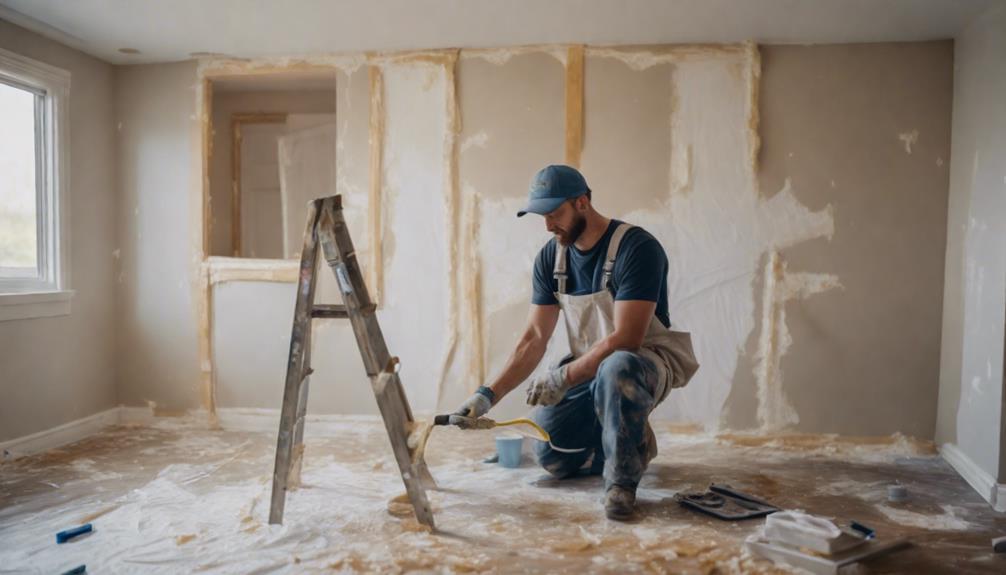
Investing time in proper prep work before painting your new house is essential for achieving a flawless and long-lasting finish. Prepping involves tasks like wall repairs, sanding, and taping. Taping alone can take around 40 minutes per room but guarantees clean edges for a professional look. The effort put into prep work directly impacts the quality of the final paint job. It helps in achieving a high-quality finish that lasts longer without needing frequent touch-ups. In addition, effective prep work not only enhances the aesthetic appeal but also saves time during the actual painting process. By addressing imperfections beforehand, you streamline the painting process and reduce the chances of interruptions or rework. Prioritizing prep work in the beginning can make the overall painting experience smoother and more rewarding.
| Task | Importance | Time Required |
|---|---|---|
| Wall Repairs | Essential | Varies |
| Sanding | Enhances Finish | 20-30 mins |
| Taping | Clean Edges | 40 mins/room |
Painting Process Overview
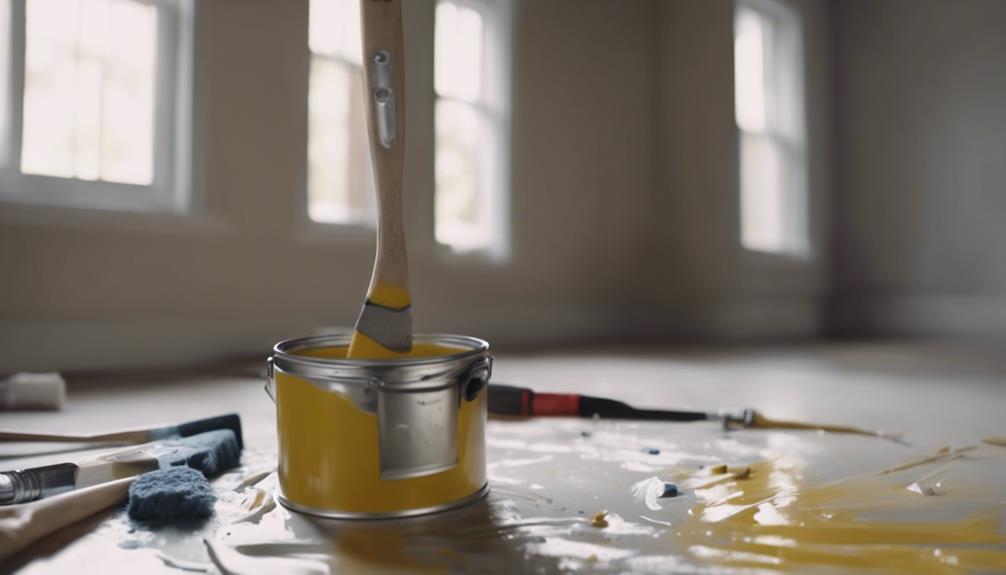
When painting the interior of a new house, it's essential to understand the key points:
Prep Work Importance,
Time Estimation Factors, and
Efficient Painting Techniques.
These elements will help you navigate the process efficiently and achieve a satisfactory result.
Prep Work Importance
Proper preparation, such as cleaning, sanding, and taping, is essential for ensuring a smooth painting process when tackling the interior of a new house. To emphasize the importance of prep work, consider the following:
- Taping alone can add around 40 minutes per room to the overall painting time.
- Ensuring thorough prep work helps in achieving a high-quality finish.
- Professional painters are efficient in prepping the surfaces before painting.
- The time spent on prep work directly impacts the overall duration of painting the interior of a new house.
Time Estimation Factors
To accurately estimate the time required for painting the interior of a new house, consider various factors such as the size, intricacy, and surfaces involved in the painting process. A professional painter estimated 3.5 weeks to complete painting in a new house, accounting for the size and details of the build.
New construction projects often demand meticulous work due to imperfections that require extra prep time. Factors like different materials, surfaces, and higher ceilings can influence the time needed for painting a new house. Quality workmanship in new constructions may necessitate additional time to guarantee a precise finish.
It's advisable to consult multiple painters for time estimates and insights on the specific challenges that painting new constructions may present.
Efficient Painting Techniques
Implementing efficient painting techniques can greatly streamline the process of painting the interior of a new house. To guarantee a smooth painting process, start by properly cleaning and prepping the walls. Remember to remove furniture, tape edges, and cover floors.
Next, focus on filling holes, sanding surfaces, and priming walls if necessary. When applying coats of paint, allow for drying time between each coat. Utilizing rollers for larger areas can speed up the painting process.
Time Estimate for Cleaning
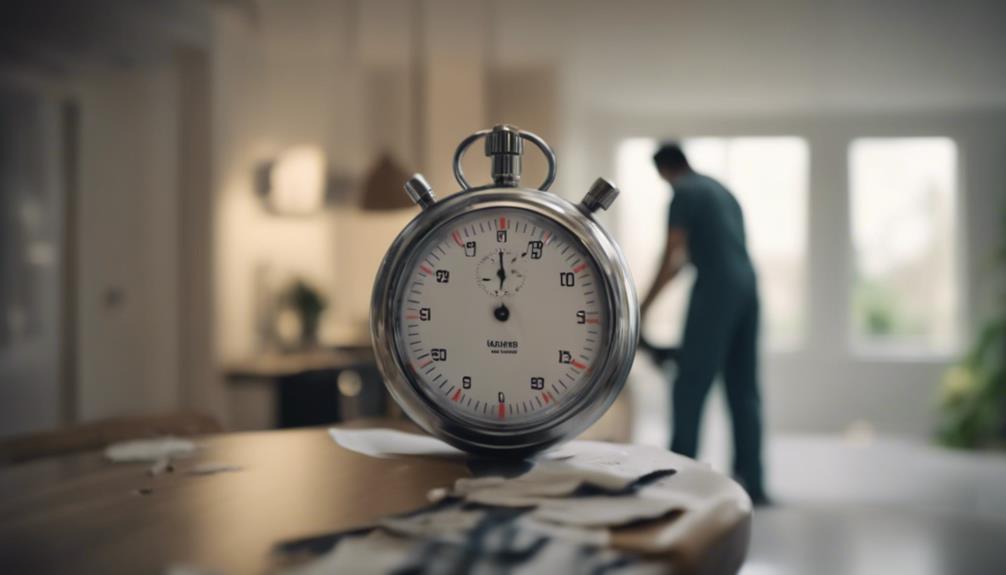
Before you begin painting the interior of your new house, allocating 1-2 days for thorough cleaning is essential. Cleaning plays an important role in ensuring proper paint adhesion to surfaces. Removing dust, grease, and mildew is key for a successful foundation.
By thoroughly cleaning walls, ceilings, and trim, you pave the way for a smooth and even paint application. This process typically involves wiping down surfaces, vacuuming, and using mild cleaning solutions. Taking the time to clean your new house properly sets the stage for a long-lasting paint job.
Time Estimate for Preparation
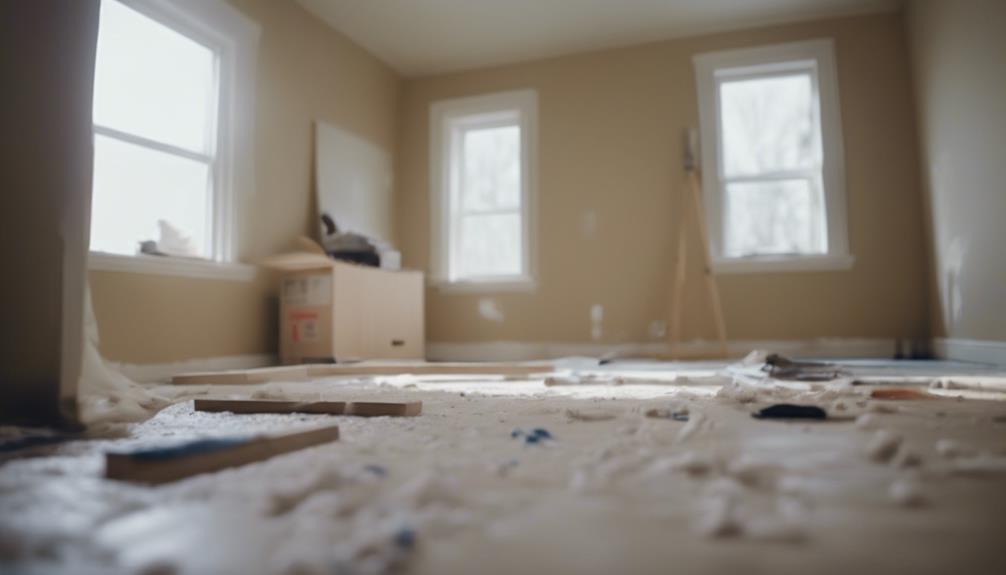
Estimating the time needed for preparation before painting the interior of your new house is essential for a successful and efficient project. To guarantee a smooth painting process, consider the following key tasks when estimating your preparation time:
- Cleaning Walls: Spending 1-2 hours cleaning and prepping walls is vital for paint adhesion.
- Removing Furniture: Factor in extra time for moving furniture and fixtures out of the rooms being painted.
- Taping Edges: Allocate time for taping edges and covering floors to protect areas not meant for painting.
- Filling Holes and Sanding Surfaces: Thoroughly fill any holes and sand surfaces for a flawless paint finish.
Time Estimate for Painting
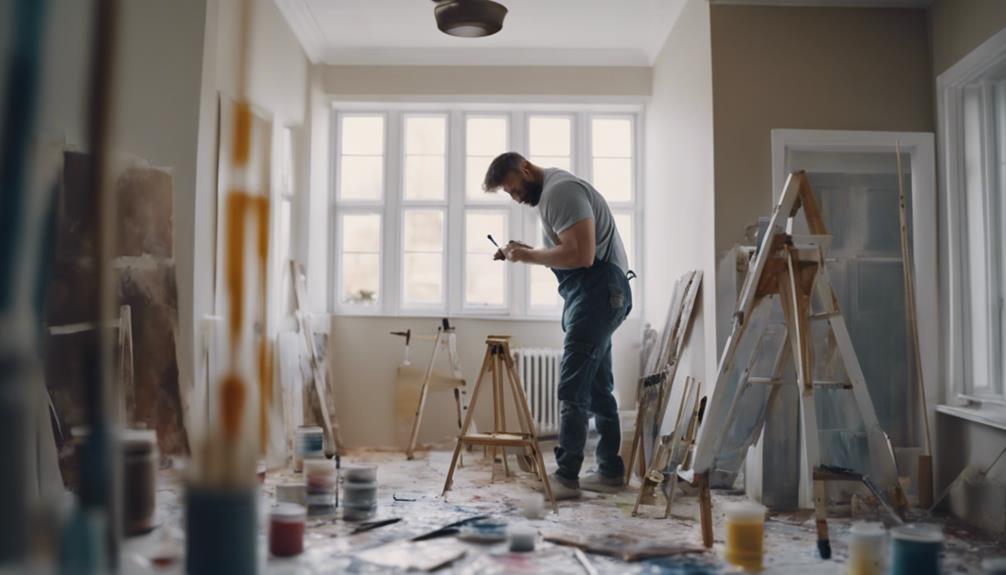
When planning the painting timeline for your new house, consider the intricate details and size of the project to guarantee a thorough estimate. Professional painters typically estimate around 3.5 weeks to paint an entire new house, factoring in the specific challenges of new construction.
New builds often require more prep work due to imperfections and different materials, impacting the overall painting time. Factors like higher ceilings and the need for quality workmanship can further extend the duration needed for painting.
It's advisable to consult with multiple painters to get accurate time estimates, considering the intricacies of your project and desired quality levels. Additionally, unexpected delays are common in new build painting projects, necessitating extra time for touch-ups and meticulous work to ensure a high-quality finish.
Be prepared for these potential delays when planning your painting timeline for the new house.
Time Estimate for Cleanup
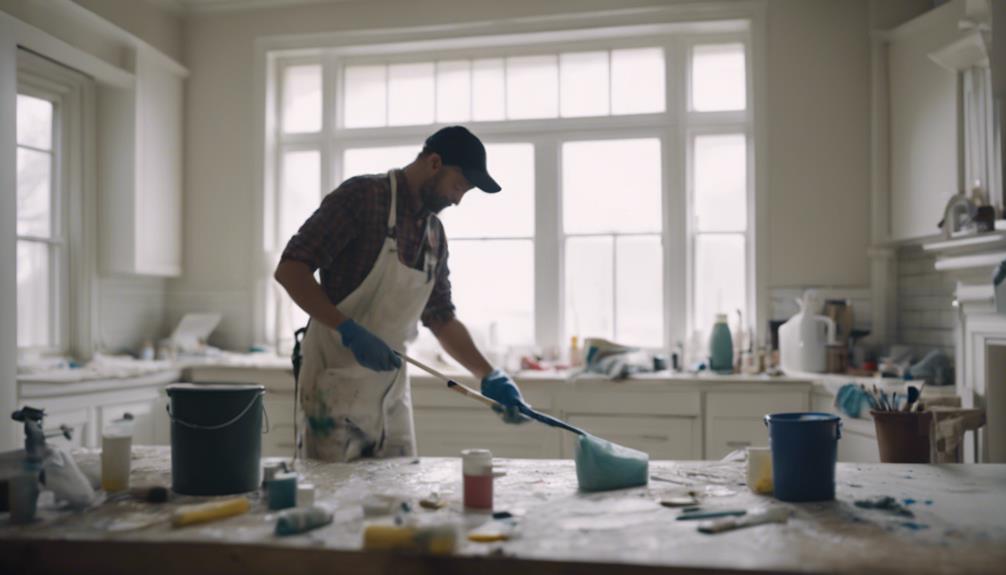
For an efficient and polished painting project, consider the time estimate for cleanup after painting the interior of a new house. Cleaning up after interior painting in a new house typically takes around 1-2 hours. To guarantee a spotless finish, tasks involve removing drop cloths, picking up tools, and properly disposing of paint cans. Professional painters excel at thorough cleanup, leaving the space in pristine condition.
DIY cleanup, on the other hand, may require dusting surfaces, organizing tools, and responsibly getting rid of paint supplies. Remember, effective cleanup plays an important role in the overall success and appearance of the painting project.
- Removing drop cloths
- Picking up tools
- Disposing of paint cans
- Ensuring a spotless finish
Frequently Asked Questions
How Long Does It Take to Paint the Inside of a New House?
To paint the inside of a new house, it typically takes about a week. This includes prep work, priming, and painting. New constructions may need extra attention due to surface imperfections. Factors like absorbent drywall or high ceilings can affect the time needed.
Consider additional time for intricate details or multiple coats. Be prepared for meticulous work, especially in new builds, to guarantee a quality paint job.
How Long Does It Take to Paint a 1500 Sq Ft House Interior?
Painting a 1500 sq ft house interior typically takes around 36 days. Factors like furniture moving, paint crew size, repairs, and prep work impact the timeline.
Cleaning, preparing, painting, and cleanup all contribute to the overall duration. The number of rooms, paint colors, coats needed, and trim painting affect the time it takes.
Hiring professional painters for efficiency and quality results is recommended.
How Many Man Hours Does It Take to Paint the Interior of a House?
To paint the interior of a house, the number of man hours required depends on factors like the size of the house, the complexity of the job, and the number of painters working. Proper planning and organization are key to maximizing efficiency.
Typically, a team of professional painters can tackle the job in a timely manner, ensuring quality results. Communication and teamwork among the crew play an essential role in completing the project within the estimated time frame.
Can You Paint a Whole House in One Day?
You can typically not paint a whole house in one day. Factors like size, complexity, and prep work make it challenging. Rushing can lead to poor quality.
Professional painters might do smaller houses in a day, but larger ones need more time. Plan for the appropriate amount of time to guarantee a thorough paint job.
Conclusion
To wrap up, painting the interior of a new house can take anywhere from a few days to a couple of weeks, depending on the size of the house, whether you choose to DIY or hire professionals, the importance of prep work, and the overall painting process.
It's important to allocate enough time for cleaning, preparation, painting, and cleanup to guarantee a successful and efficient painting project. Plan accordingly and you'll have a freshly painted home in no time!
Mason – Your Product Expert Mason is your go-to product expert, carefully selecting each item in our collection to ensure it meets your comfort, functionality, and style needs. With his attention to detail and commitment to quality, he ensures that every product we offer enhances your home experience.
-

 Vetted8 months ago
Vetted8 months ago15 Best EMS Foot Massagers for Neuropathy to Soothe Your Feet
-

 Vetted7 months ago
Vetted7 months ago14 Best Personalized Father's Day Gifts for Your Husband – Show Him You Care
-
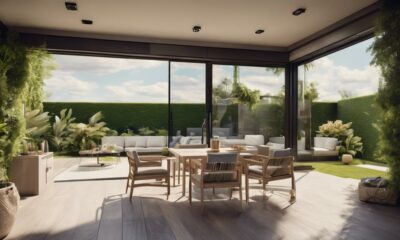
 Alfresco7 months ago
Alfresco7 months agoAlfresco Stacker Doors: Seamless Indoor-Outdoor Living!
-
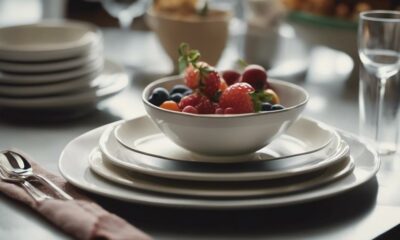
 Tableware and Dining Accessories2 weeks ago
Tableware and Dining Accessories2 weeks agoWhat Is the Meaning of the Word Tableware
-
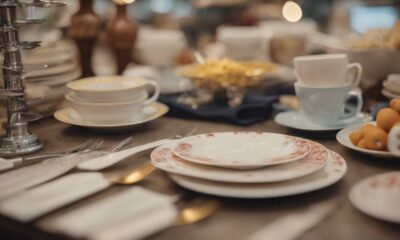
 Tableware and Dining Accessories2 weeks ago
Tableware and Dining Accessories2 weeks agoWhen Is Tableware on Sale at Hobby Lobby
-
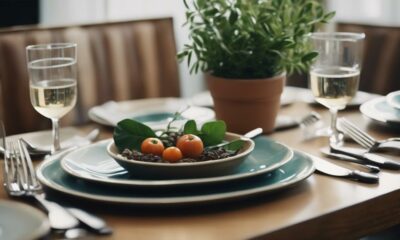
 Tableware and Dining Accessories2 weeks ago
Tableware and Dining Accessories2 weeks agoWhich of the Following Is Not Classified as Tableware
-

 Vetted8 months ago
Vetted8 months ago15 Best Detergents for Wool: Keep Your Woolens Looking Fresh and Fabulous
-

 Craft and Textiles8 months ago
Craft and Textiles8 months ago15 Best Places to Buy Appliances for Your Home – Top Retailers Reviewed








